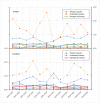Human behavior determinants of exposure to Anopheles vectors of malaria in Sumba, Indonesia
- PMID: 36374859
- PMCID: PMC9662732
- DOI: 10.1371/journal.pone.0276783
Human behavior determinants of exposure to Anopheles vectors of malaria in Sumba, Indonesia
Abstract
Malaria vector control interventions in Sumba, Indonesia, have not been able to eliminate malaria. Human drivers of exposure to Anopheles bites were investigated as part of a larger clinical trial evaluating the impact of a spatial repellent product on malaria incidence. Human behavioral observations (HBOs) evaluating temporal and spatial presence, sleeping behaviors, and insecticide treated net (ITN) use, were collected parallel to entomological collections-indoor and outdoor human landing catches (HLCs), and house hold surveys. Data demonstrates that mosquito access to humans, enabled by structurally open houses, is evident by the similar entomological landing rates both inside and outside households. The presence of animals inside houses was associated with increased mosquito entry-however, the number of humans present inside houses was not related to increased mosquito landing. Analyzing mosquito landing rates with human behavior data enables the spatial and temporal estimation of exposure to Anopheles bites, accounting for intervention (ITN) presence and usage. Human behavior adjusted exposure to Anopheles bites was found to be highest in the early in the evening, but continued at lower levels throughout the night. Over the night, most exposure (53%) occurred when people were indoors and not under the protection of nets (asleep or awake) followed by exposure outside (44%). Characterized gaps in protection are outdoor exposure as well as exposure indoors-when awake, and when asleep and not using ITNs. Interestingly, in the primary trial, even though there was not a significant impact of the spatial repellent on vector biting rates by themselves (16%), when factoring in human behavior, there was approximately 28% less exposure in the intervention arm than in the placebo arm. The treated arm had less human behavior adjusted bites in all spaces evaluated though there was proportionally higher exposure indoors. This analysis points to the importance of using HBOs both towards understanding gaps in protection as well as how interventions are evaluated. To mitigate ongoing transmission, understanding context specific spatial and temporal exposure based on the interactions of vectors, humans and interventions would be vital for a directed evidence-based control or elimination strategy.
Copyright: © 2022 Rozi et al. This is an open access article distributed under the terms of the Creative Commons Attribution License, which permits unrestricted use, distribution, and reproduction in any medium, provided the original author and source are credited.
Conflict of interest statement
The authors have declared that no competing interests exist.
Figures





References
-
- "Zero malaria starts with me”: history of malaria elimination in Indonesia helps to shape a malaria-free future [Internet]. [cited 2020 Sep 17]. https://www.who.int/indonesia/news/feature-stories/detail/zero-malaria-s....
-
- Mahendradhata Y, Trisnantoro L, Listyadewi S, Soewondo P, MArthias T, Harimurti P, et al.. The Republic of Indonesia Health System Review. Vol. 7. 2017. 1 p.
-
- Gani A, Budiharsana MP. The Consolidated Report on Indonesia Health Sector Review 2018. 2018;56.
Publication types
MeSH terms
Substances
LinkOut - more resources
Full Text Sources
Medical

